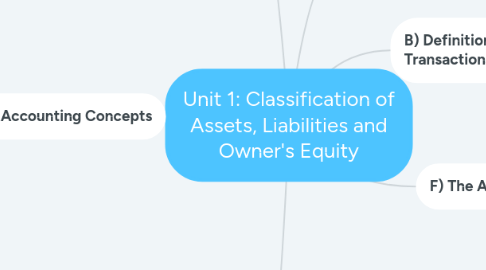
1. C) The Accounting Process
1.1. 1) Source Document
1.2. 2) Books of Original Entry
1.3. 3) Ledgers
1.4. 4) Trial Balance
1.5. 5) Statement Of Comprehensive Income
1.6. 6) Statement of Financial Positions
2. D) Accounting Concepts
2.1. Accounting Entity/Business Entity Concept
2.1.1. business is a separate entity from its owner
2.1.1.1. All the transactions are recorded from the point of view of the business. That including contributing into or withdrawing from the business
2.2. Going Concern Concept
2.2.1. The business Indefinite Economic life
2.2.1.1. The business will buy assets to help it carry out its operation for a long time.
2.2.1.1.1. As the assets are not to be sold off soon after they are acquired, they are usually recorded at historical cost.
2.3. Accounting Period Concept
2.3.1. The laws require some business to prepare their financial statement at least once every 4 months and other business at least once a year
2.4. Monetary Concept
2.4.1. Only Business activities that can be measured using money are recorded
2.5. Historical Cost Concept
2.5.1. transactions should be recorded at their original cost.
2.5.1.1. Which means before additional terms are added such as discounts.
2.6. Consistency Concept
2.6.1. Accounting Policies and methods must be consistent from period to period
2.6.1.1. Financial Performance then can be meaningfully compared across financial periods.
3. E) Element of Accounting
3.1. 1) Assets
3.1.1. Definition: Items of value owned or controlled by the business
3.1.1.1. Example: Buildings, Motor Vehicles, Furniture and Fittings and etc
3.2. 2) Liabilities
3.2.1. Definition: Amount owned by business to suppliers or third parties
3.2.1.1. Example: Loan from Bank, Creditors and etc.
3.3. 3) Revenue/Income
3.3.1. Definition: Amount that a business earns from selling goods or from daily business activities or non- business activities
3.3.1.1. Example: Sales, Rental Income, Commission Income and etc.
3.4. 4)Expenses
3.4.1. Definition: Payments that are incurred for the day-to-day business activities
3.4.1.1. Example: Advertising Expenses, Utilities Expense, Rental Expenses
3.5. 5) Drawings
3.5.1. Definition: Amount of money or resources brought out of the business by the owner
3.5.1.1. Example: Cash or Goods taken from business for personal use
3.6. 6) Capital
3.6.1. Definition: Amount of money or resources brought into the business by the owner
3.6.1.1. Example: Owner brings in cash or assets such as Motor Vehicles, Office Equipment and etc for business use
4. A) Definition of Accounting
4.1. Accounting is the process of Recording, Summarising, Analysing, Interpreting and Reporting the business transactions of an organisation.
4.1.1. Purpose is to make decisions for the business
5. B) Definition of Business Transactions
5.1. A business transaction is an activity carried out by the business to provide goods and services in exchange for money.
5.1.1. Literal Meaning? You give me money I give you goods/Services
